#NEULAND at Kunsthaus Kaufbeuren
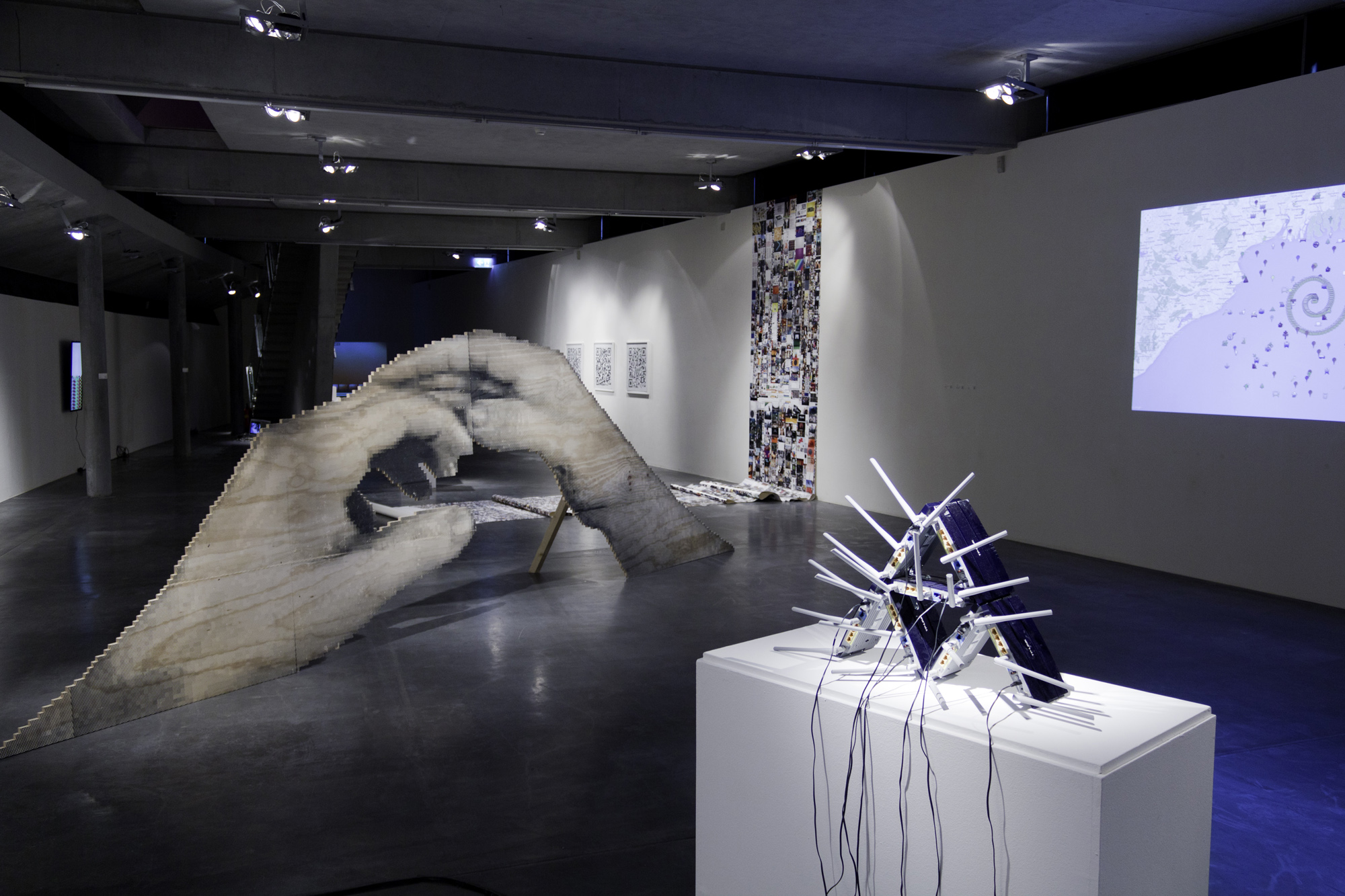
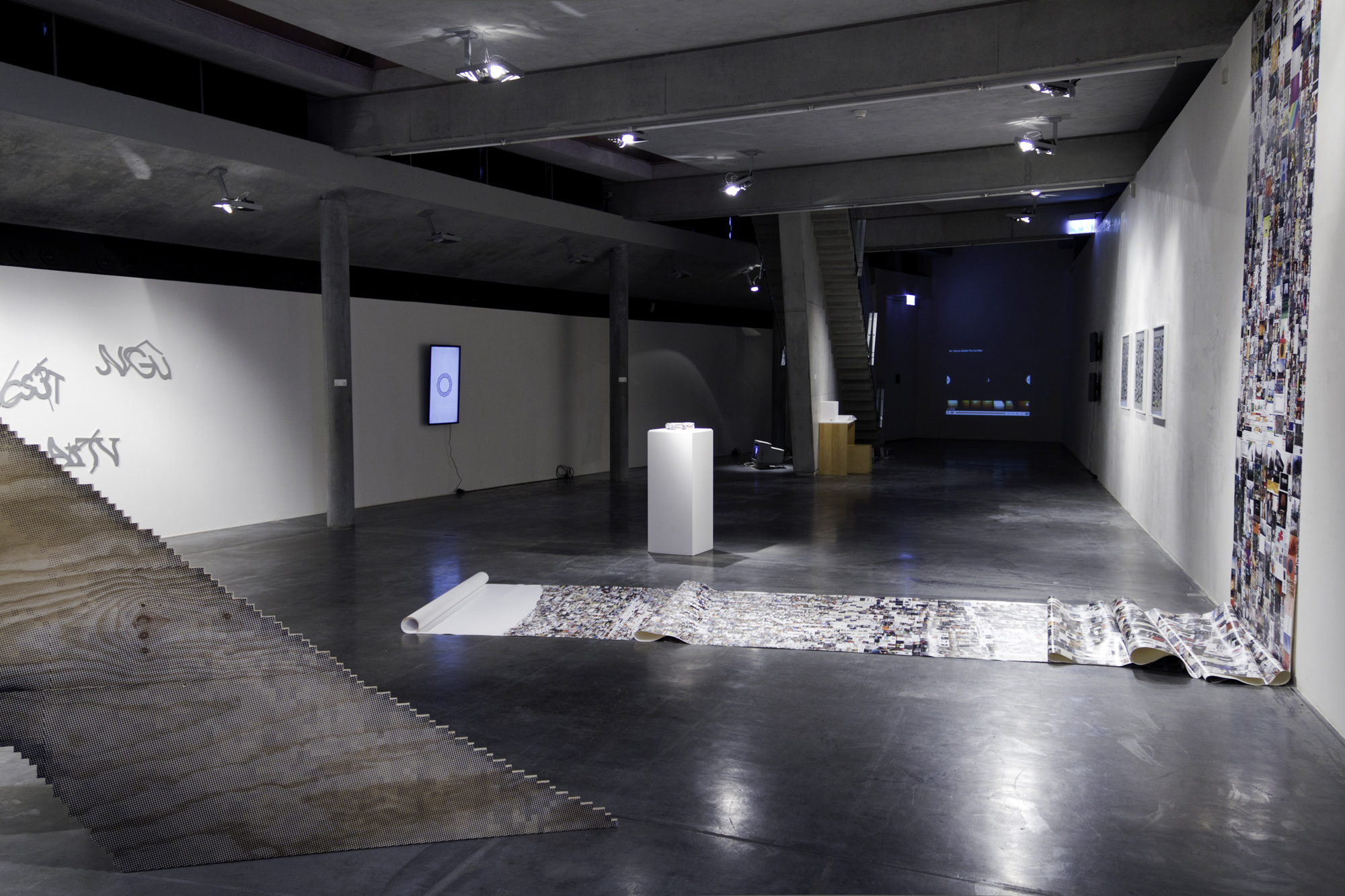
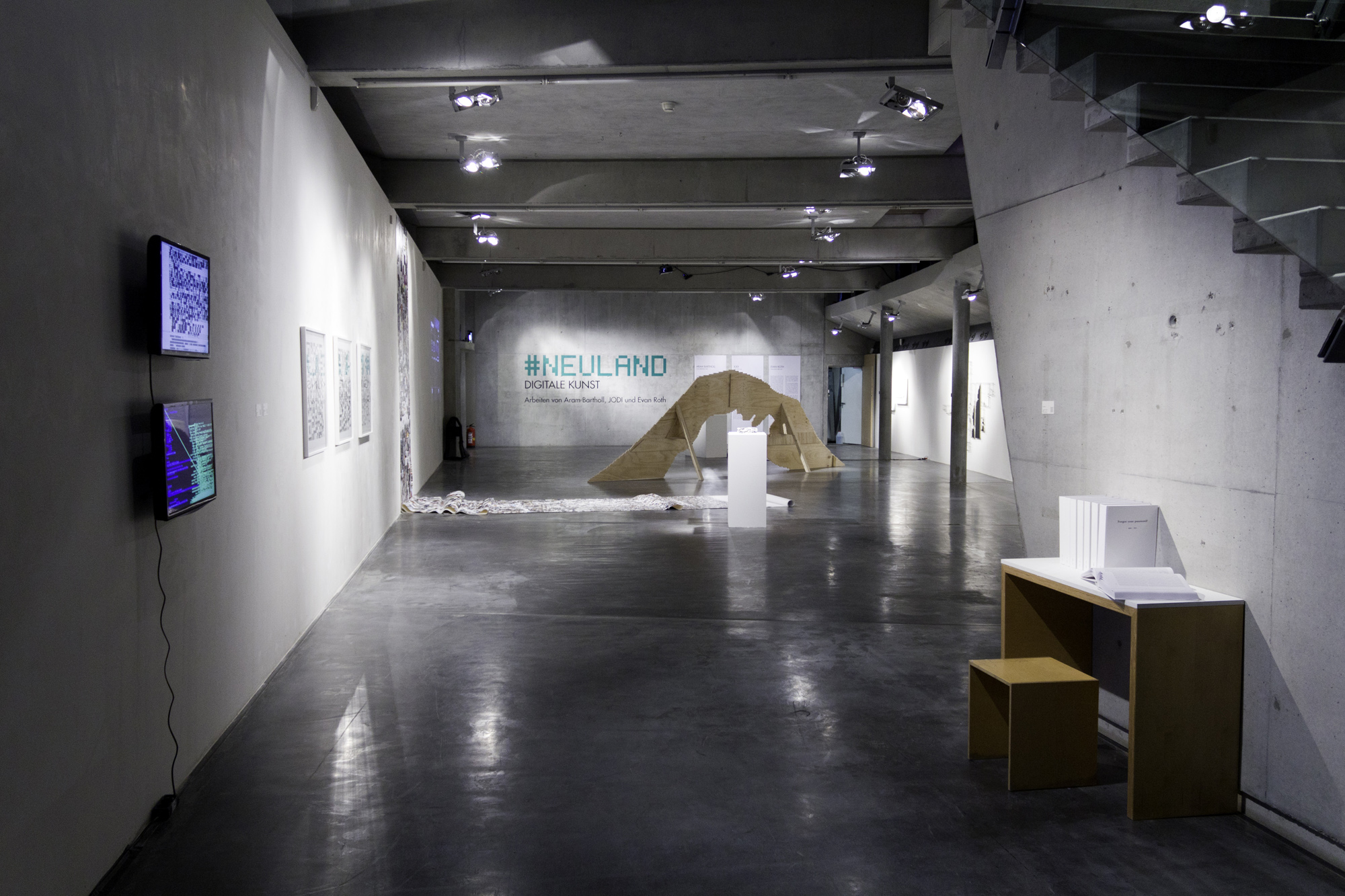
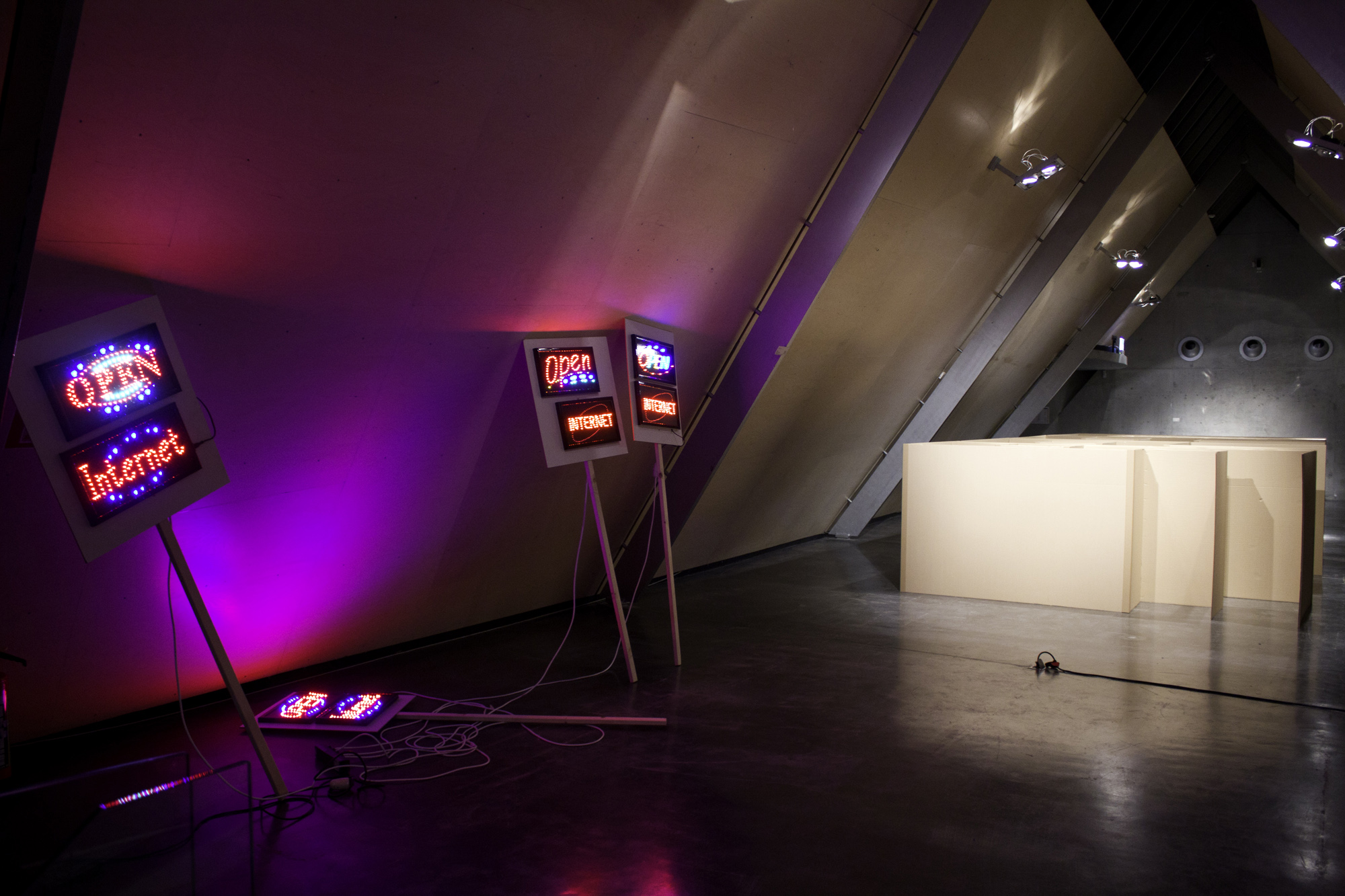
#NEULAND
March 28 – June 28, 2015
Kunsthaus Kaufbeuren
with:
Aram Bartholl, JODI and Evan Roth
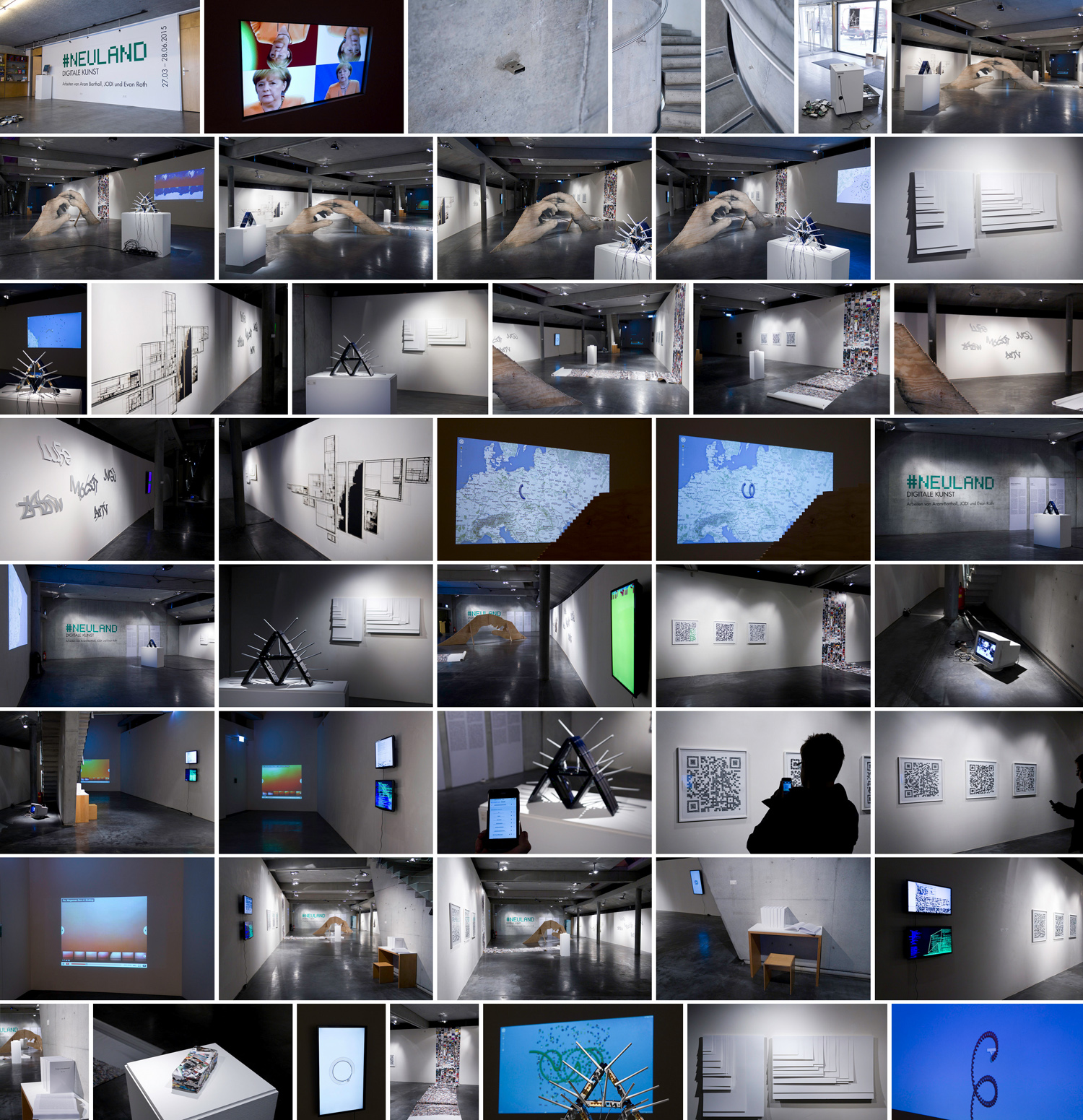
flickr set
Die Ausstellung Decoding the Black Box bringt Künstlerinnen und Künstler zusammen, die Licht in diesen dunklen Raum und die Prozesse werfen, die sich in ihm ereignen. Sie legen dabei nicht nur die Funktionsweisen digitaler Technologien wie beispielsweise von künstlicher Intelligenz offen, sondern visualisieren zugleich die Auswirkungen, die sie auf unsere Wahrnehmung von Realität und unser In-der-Welt-Sein haben. Während sie die ökonomischen und machtpolitischen Strukturen der digitalen Technologien und insbesondere des Internets transparent machen, zeigen sie Gegenentwürfe für eine dezentralisierte, humanere und demokratischere Nutzung ebendieser auf.
14:00 – 16:00
Killyourphone is an open workshop format. Participants are invited to make their own signal blocking phone pouch. In the pouch the phone can’t send or receive any signals. It is dead! This workshop was run for the first time at the Chaos Communication Congress in Hamburg end of 2013.
Monday 25th of March, 7:00 PM at Web Cafe, Eptanisou 40, 113 61 , Kypseli – Athens
with:
!Mediengruppe Bitnik with Selena Savić & Gordan Savičić , Ingrid Hideki, Joanna Bacas, Kyriaki Goni, Maria Mavropoulou, Marina Gioti, Marsunev, Nadja Buttendorf, Theo Triantafyllidis
Curated by Aram Bartholl & Socrates Stamatatos
Speed Show lands in Greece, the country of souvlaki, the sun (yes we can claim that they originated a celestial body), ouzo, feta, an enormous financial debt. Currently, Greece is also trending for all the wrong reasons namely, gentrification, queerphobia, state crimes and more dystopic incidents.
As 2024 unfolds, we find ourselves amidst a whirlwind of confusion, bombarded with a cacophony of online horrors to consume, an attention span further abbreviated by TikTok’s algorithm and the barrage of incoming stitches.
Stitches Incoming serve as a conduit for creators to engage and converse, traversing from one topic to the next. They have evolved into a new social fabric, weaving connections within an ever-shifting digital and physical landscape while also serving as a testament to personal and collective traumas, both past and present.
What unites the participating digital artists? Perhaps everything and nothing simultaneously… Departing from the traditional Speed Show setup, where artworks are carefully stacked inside internet cafe computers, and drawing inspiration from the structure of TikTok stitches, each piece seems to propel the conversation forward, or perhaps uses the next as a springboard for its own narrative.
Stitch this and stitch that, we have everything you ever wanted (maybe) ! Are we stuck in an infinite loop of sh*tposting, valuable content, the highlight of social issues, personal and interpersonal experiences?
Maybe! Come and find out…
More info on Speed Shows at https://speedshow.net/stitch-incoming/
14:00 – 16:00
Killyourphone is an open workshop format. Participants are invited to make their own signal blocking phone pouch. In the pouch the phone can’t send or receive any signals. It is dead! This workshop was run for the first time at the Chaos Communication Congress in Hamburg end of 2013.
14:00 – 16:00
Killyourphone is an open workshop format. Participants are invited to make their own signal blocking phone pouch. In the pouch the phone can’t send or receive any signals. It is dead! This workshop was run for the first time at the Chaos Communication Congress in Hamburg end of 2013.




#NEULAND
March 28 – June 28, 2015
Kunsthaus Kaufbeuren
with:
Aram Bartholl, JODI and Evan Roth

flickr set
The exhibition Are you still there? assembles twelve positions dealing with questions of presence and representation of identity in the digital age. Online identities like Facebook profiles, Instagram or Whatsapp accounts are constantly gaining significance for our everyday lives: Who are we online? How do we present ourselves via social media? What is our status and when was the last time we have been online? The revelations of Edward Snowden have taught us that the NSA and similar organisations are collecting our data on a large scale: These data have been generated by ourselves on a day-to-day basis simply because we have been communicating with other people.
The title Are you still there? references a certain situation in the chat program Google Hangouts: After an interrupted video call the browser window wants to know if the user is still there. Are we still there? How much time do we spend online? What kind of pictures do we have of each other and how do we picture the world nowadays?
The artworks displayed in the exhibition cover a wide range of contemporary art, including references of classical internet art, online interventions and performance art. With animated GIF-tableaus, video collages and interactive artworks the artists question the crucial relationship of society, internet and identity.
Aram Bartholl 2015
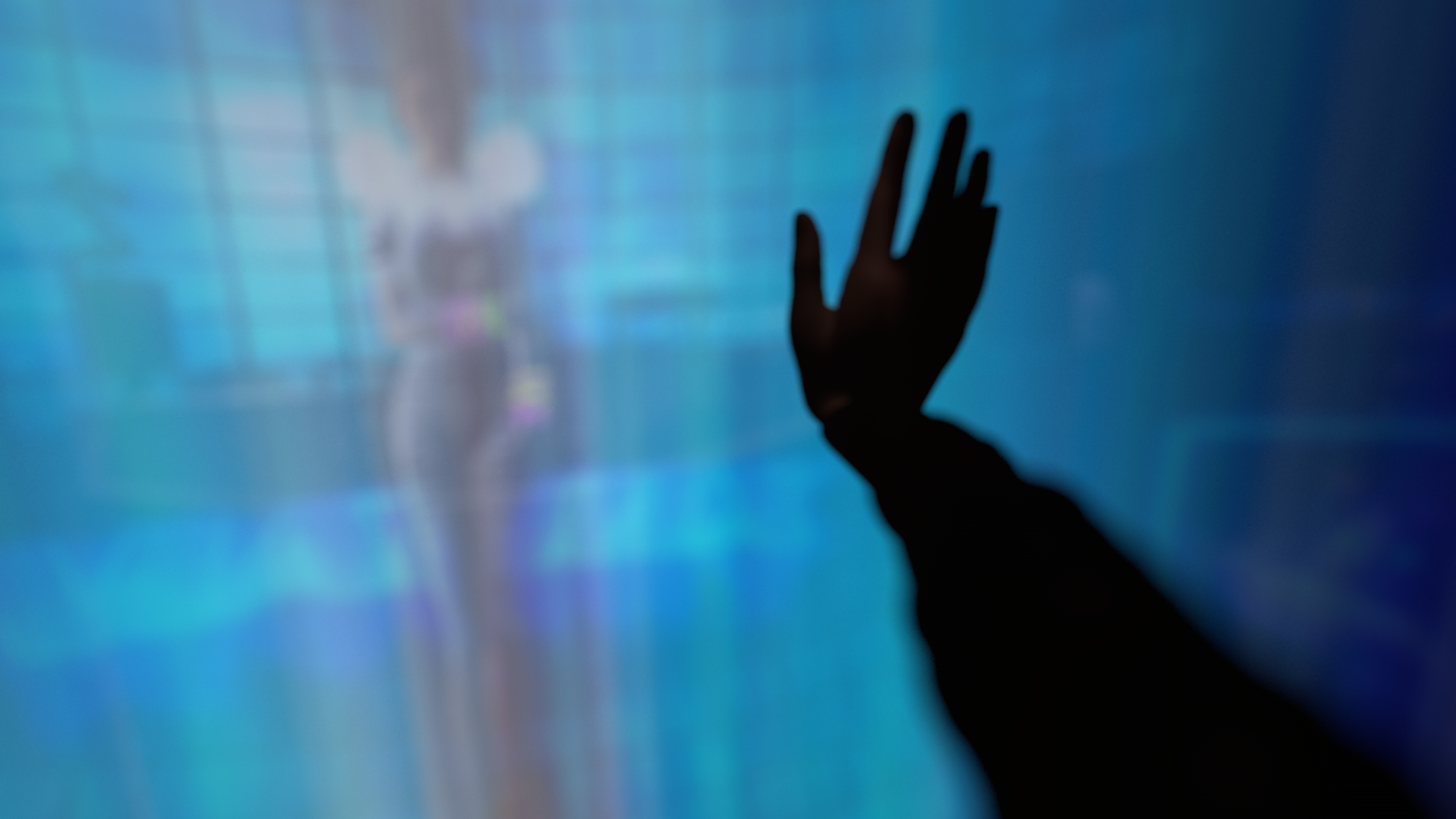
Club Rothko (2015), LaTurbo Avedon
Offline Art: Are you still there?
part of ‘Hamster – Hipster – Handy.’
at Museum Angewandte Kunst, Frankfurt
April 25th, – July 05th, 2015
Opening April 24, 6:00 pm
Curated by Aram Bartholl
Participating artists:
Like Pearls (2014), Morehshin Allahyari
“Like Pearls” is a mash-up of sex and romance collected from my Farsi email spam and online underwear stores based in Iran. I manipulated and layered GIFs such as hearts, flowers, candles, birds, and butterflies on top of digital advertisements.
34 frames (2015), Alma Alloro
In this series I am making quilt in the (american) traditional way, using singular-colour cotton fabric and a sewing machine. I scan the quilt and used each of the patches as one frame in the animation, inspired by early experimental animators such has Hans Richter and Oskar Fischinger’s research of forms and motion, the art and craft” movement, focusing on the craft element of digital art.
Blue Brightness (2012), Anthony Antonellis
A bluescreen usually represents ‘no signal’ on beamers or a crashed system on windows. Antonellis uses this metaphor combined with the brightness control and a very faint mirror image of himself to question online identity. How does the computer (Apple mirror glas screens) do reflect on us?
Club Rothko (2015), LaTurbo Avedon
LaTurbo Avedon is an artist-avatar whose existence and creative output resides entirely online. Without a real world referent, LaTurbo is a digital manifestation of a person that has never existed outside of a computer. Avedon’s digital sculptures and environments disregard this lack of physicality, and instead emphasize the practice of virtual authorship.
Netzwerkfernweh (2015), James Bridle
Netzwerkfernweh is a mobile, offline interpretation of rorschmap.com, an ongoing reimagining of digital cartography. Inspired by the kaleidoscope (literally: “observer of beautiful things”), Netzwerkfernweh renders historical and contemporary maps strange and beautiful, as true maps should be. Mobile devices inherently place us at the centre of the world; Netzwerkfernweh scrambles the world.
High Retention – Slow Delivery!! (2014), Constant Dullaart
100,000 Followers for Everyone! 2.5 million Instagram followers were bought and distributed by artist Constant Dullaart amongst a personal selection of active art-world Instagram accounts. Artificial quantified social capital redistributed, Social media Socialism.
Please wait (2012) Claudia Mate
Claudia Mate motifs deal with humanities perception of scale, self, and recognition of space. Her work Please wait is a constant reminder how much time we spend in front of screens waiting for pages to be loaded, files to be processed or images to appear.
BEFNOED (2014) Eva & Franco Mattes aka 0100101110101101.org
We give instructions to anonymous workers to realize webcam performances. The performers are hired through crowdsourcing services, so we do not know who they are, where they are, or even their motivations. The resulting videos are then dispersed on obscure, peripheral or forgotten social networks around the world, in Cambodia, Russia, China, South Africa…
Not So Colossal Cave Adventure (2015) Niko Princen
“You are in a cave, there is no Internet!” Niko Princen presents a short adventure in which the user eventually is asked to go back online to find the Butterfly (Dutch: Vlinder.) on a seperate app for Android phones.
LSTM (2015) Sebastian Schmieg
Credits: Residency at the WRO Art Center
Long Short Term Memory is a neural network that memorises every book of the futurologist Ray Kurzweil by permanent training. The net learns the rules of composition by which we − and especially Kurzweil − form words, sentences and propositions. Based on this acquired knowledge, the system generates new chains of signifiers that evolve and finally, by constant practice, become words, neologisms and new ideas.
There You Are! (2015) UBERMORGEN
The absence of a societal purpose of online poker allows us to withdraw ourselves from the art world and exlusively focus on the aesthetically pure, on a game of distribution and self-awareness, the game of poker. You can find us (viennazombie & lizvlx) every day and most nights on Pokerstars.com, playing high, variance strategy, frequently hijacking and going tilt from time to time.
Blue Screen (2014) Video excerpt , Addie Wagenknecht
Commissioned by NewHive. Courtesy bitforms gallery, New York.
“Blue Screen” is a narrative composed of three unique webpages reflecting on recent controversies targeting women working in the gaming and technology industries. The overwhelming accumulation of abuse culminated in the psychological halting state embodied by this work. Something is broken. The system has crashed and must be rebooted. Artists have a responsibility to ask questions, challenge boundaries, and burn up what culture doesn’t need in order to make space for change.
Browser-based digital art works are broadcast locally from wifi routers which are not connected to the Internet. Each art work is assigned a single wifi router which is accessible through any device, like smart-phones, tablets or laptops. To access the different art works, the visitor has to connect to each network individually. The name of the network reflects the name of the artist. No matter what URL is opened, only the specific artwork appears in the browser. A small web server holding the art piece is installed on a USB flash drive which is connected to the router. Like frames holding the art, the routers are hung in the exhibition space which is otherwise empty. The art itself becomes visible only on the visitor’s private screen.The pieces are locally widely accessible but disconnected from the Internet
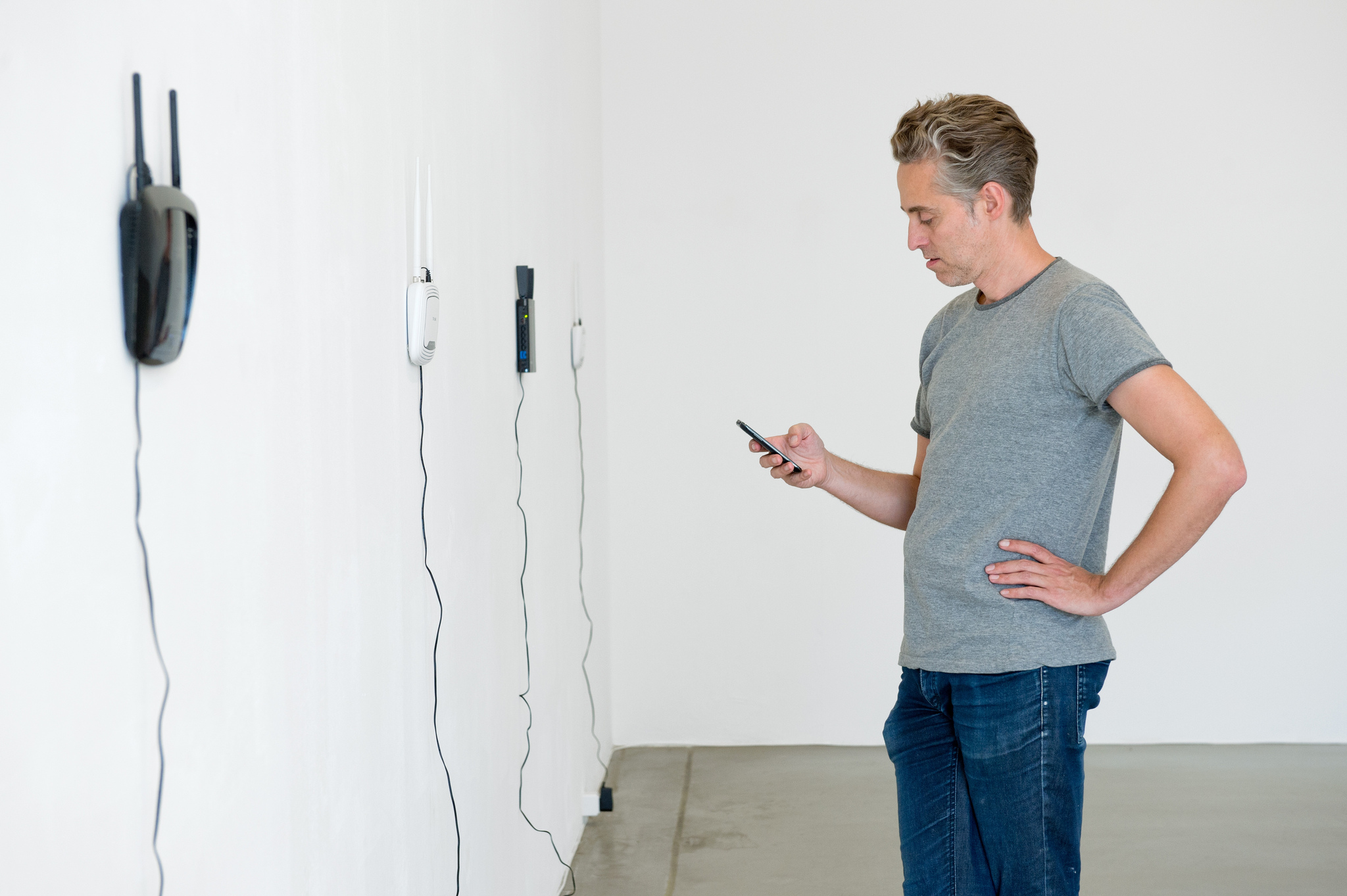
Offline Art: hardcore, Kasseler Kunstverein 2013
See also: Offline Art: new2 at xpo Galerie, Paris 2013
German:
Die Ausstellung Are you still there? versammelt 12 Positionen, die sich mit Fragen rund um Präsenz und Repräsentation von Identität im Zeitalter von Internet und Social Media auseinandersetzen. In zunehmendem Maße spielt die Online-Identität, wie z.B. ein Facebook-Profil, Instagram- oder Whatsapp-Account, eine tragende Rolle in unserem digital geprägten Leben. Wer sind wir online? Wie stellen wir uns dar? Was ist dein Status und wann warst du zuletzt online? Seit Snowden wissen wir, dass NSA und Co in großem Stil Daten über uns speichern, Daten, die wir tagtäglich selbst generieren in Kommunikation mit einer Vielzahl von Menschen zur gleichen Zeit.
Der Titel Are you still there? bezieht sich auf einen bestimmten Moment im Chat-Programm Google Hangout. Nach einem abgebrochenen Videoanruf fragt das Browserfenster den_die User_in nach einer bestimmten Zeit, ob er oder sie noch da sei. Sind wir noch da? Wie viel Zeit verbringen wir täglich am Bildschirm? Welche Bilder haben wir voneinander und wie ist unser Bild von der Welt heute?
Die Arbeiten der Ausstellung decken ein weites Spektrum zeitgenössischer Kunst ab. Mit Bezügen zur klassischen Netzkunst, Online-Interventionen und Performancekunst diskutieren die Künstler_innen aktuelle Fragen rund um Gesellschaft, Internet und Identität. Von Animated GIF-Tableaus über Video-Collagen bis zu interaktiven Arbeiten werden mit unterschiedlichen Techniken aktuelle Themen der vom Kulturraum Internet beherrschten Gesellschaft befragt und erforscht.
Are you still there?
Teil von ‘Hamster – Hipster – Handy.’
Museum Angewandte Kunst, Frankfurt
April 25th, – July 05th, 2015
Opening April 24, 6:00 pm
Kuration: Aram Bartholl
Teilnehmende Künstler:
Like Pearls (2014), Morehshin Allahyari
Like Pearls vermengt Bilder aus Spam- und Werbe-Emails sexuellen Inhalts zu etwas Neuem: Animierte GIFs wie Herzen, Blumen, Kerzen, Vögel und Schmetterlinge werden mit digitaler Werbung eines Unterwäsche-Onlineshops, dessen Sitz im Iran ist, kombiniert.
34 frames (2015), Alma Alloro
In dieser Serie habe ich mit einfarbigen Baumwollstoffen und einer Nähmaschine eine Steppdecke in amerikanischer Tradition hergestellt. Ich habe die Decke gescannt und jedes Patch als einen Frame der Animation verwandt. Der Fokus liegt auf dem Handwerkselement digitaler Kunst − dazu wurde ich von frühen experimentellen Animationskünstlern wie Hans Richter und Oskar Fischinger, deren Untersuchungen von Formen und Bewegungen sowie der Arts and Crafts-Bewegung inspiriert.
Blue Brightness (2012), Anthony Antonellis
Ein blauer Bildschirm bei Beamer-Projektionen oder einen Systemabsturz bei Windows bedeutet normalerweise „Kein Signal“. Antonellis kombiniert diese Metapher mit der Helligkeitseinstellung und einem kaum wahrnehmbaren Spiegelbild von ihm selbst, um die sogenannte Online-Identität zu hinterfragen. Wie reflektiert uns der Computer (Apple Spiegelglas Bildschirme)?
Club Rothko (2015), LaTurbo Avedon
LaTurbo Avedon ist ein Künstler-Avatar, dessen Existenz und kreative Produktion ausschließlich online zu finden ist. Ohne eine Referenz in der realen Welt ist LaTurbo eine digitale Manifestation einer Person, die nie außerhalb eines Computers existiert hat. Avedons digitale Skulpturen lassen diesen Mangel physischer Repräsentation jedoch außer Acht und betonen umso mehr die Praxis virtueller Autorschaft.
Netzwerkfernweh (2015), James Bridle
Netzwerkfernweh ist eine mobile, offline Interpretation von rorschmap.com, eine fortwährende Re-Imagination digitaler Kartographie. Inspiriert durch das Kaleidoskop (wörtlich: Sehen schöner Formen) wirken historische und aktuelle Karten im Netzwerkfernweh fremd und schön zugleich. Mobilgeräte machen uns zum Zentrum der Welt, Netzwerkfernweh zerteilt, verdoppelt und vermischt sie.
High Retention – Slow Delivery!! (2014), Constant Dullaart
100.000 Follower für jeden! 2.5 Millionen Instagram Follower wurden von Constant Dullaart für einer persönlichen Auswahl von aktiven Kunst-Instragram-Accounts gekauft und verteilt. Artifiziell quantifiziertes soziales Kapitel wird so redistribuiert: Social Media Sozialismus.
Please wait (2012) Claudia Mate
Claudia Mates Motive beschäftigen sich mit der menschlichen Wahrnehmung von Maßen und Maßstäben, des Selbst sowie von Raum. Ihre Arbeit Please wait erinnert daran, wieviel Zeit wir vor Bildschirmen verbringen, darauf wartend, dass eine Internetseite lädt, Dateien verschoben werden oder Bilder erscheinen.
BEFNOED (2014) Eva & Franco Mattes aka 0100101110101101.org
Wir geben anonymen Online Arbeiter_innen Instruktionen, um Webcam-Performances durchzuführen. Diese Mitarbeiter_innen werden durch Crowdsourcing rekrutiert − wir wissen nicht, wer oder wo sie sind und kennen ihre Motivationen nicht. Die daraus entstandenen Videos werden über periphere oder vergessene soziale Netzwerke auf der ganzen Welt verteilt, u.a. in Kambodscha, Russland, China, Südafrika…
Not So Colossal Cave Adventure (2015) Niko Princen
„Du befindest Dich in einer Höhle, es gibt hier kein Internet!” Niko Princen präsentiert ein kurzes Abenteuer, in dem die User_innen schließlich doch online gehen müssen, um ‚The Butterfly‘ (Niederländisch: Vlinder) zu finden − eine App für Android Smartphones.
LSTM (2015) Sebastian Schmieg
Credits: Residency at the WRO Art Center
Long Short Term Memory ist ein neuronales Netz, welches durch kontinuierliches Training alle Bücher des Futurologen Ray Kurzweil verinnerlicht. Dabei eignet sich das Netz die Prinzipien an, nach denen wir – und Kurzweil im Speziellen – Wörter, Sätze und Aussagen durch das Aneinanderreihen von Zeichen bilden. Aufbauend auf dem Gelernten generiert das System in einem zweiten, ebenfalls konstant ausgeführten Vorgang neue Zeichenketten, die sich mit fortschreitendem Training zu Wörtern, Wortschöpfungen und letztlich zu neuen Ideen entwickeln.
There You Are! (2015) UBERMORGEN
Die Abwesenheit eines gesellschaftlichen Zwecks von Online Poker erlaubt es, uns von der Kunstwelt zurückzuziehen und ausschließlich auf das nur Ästhetische zu konzentrieren, auf ein Spiel der Verteilung und Selbsterkenntnis: das Pokerspiel. Man findet uns (viennazombie & lizvlx) nahezu jeden Tag und jede Nacht auf Pokerstars.com. Dort spielen wir hohe Einsätze, Abweichungsstrategien, mit häufigem Hijacking und ab und zu Tilt.
Blue Screen (2014) Video excerpt , Addie Wagenknecht
Commissioned by NewHive. Courtesy bitforms gallery, New York.
Blue Screen vereint Erzählungen dreier einzigartiger Webseiten, die jüngste Kontroversen um Frauen verhandeln, die in Gaming- und Technologiebranchen arbeiten. Die überwältigende Ansammlung von Missbrauch kulminiert im psychologischen Zustand des Stillstandes, der mit diesem Kunstwerk verkörpert wird: Etwas ist kaputt gegangen. Das System ist zusammengebrochen und muss neu gestartet werden. Künstler haben die Verantwortung und Aufgabe, Fragen zu stellen, Grenzen anzuzweifeln, und das zu vernichten, was die Kultur nicht braucht, sodass Platz für Neues geschaffen wird.
Das OFFLINE ART Ausstellungskonzept
Die browserbasierten, digitalen Kunstwerke werden vor Ort mittels WLAN-Router zugänglich gemacht, die nicht mit dem Internet verbunden sind. Zu jedem Kunstwerk gehört ein WLAN-Router, der mit jeglicher Art von Geräten wie Smartphones, Tablets und Laptops verbunden werden kann. Um Zugang zu den unterschiedlichen Kunstwerken zu bekommen, muss sich der_die Besucher_in mit dem jeweiligen Netzwerk verbinden. Der Name des Netzwerks ist zugleich der Name des Künstlers. Es spielt keine Rolle, welche URL im Browser geöffnet ist, es erscheint immer nur das jeweilige Kunstwerk. Die Kunstwerke sind auf einem USB-Stick, der direkt am Router angeschlossen ist gespeichert. Vergleichbar mit Bilderrahmen, die Kunstwerke umschließen, hängen die Router in der Ausstellung, in der ansonsten nichts zu sehen ist. Das Kunstwerk wird damit immer nur für jeden Besucher individuell auf dessen privatem Bildschirm sichtbar. Die Kunstwerke sind lokal erreichbar, aber nicht mit dem Internet verbunden.
Sie auch Dokumentation:
Offline Art: new2 bei xpo Galerie, Paris 2013
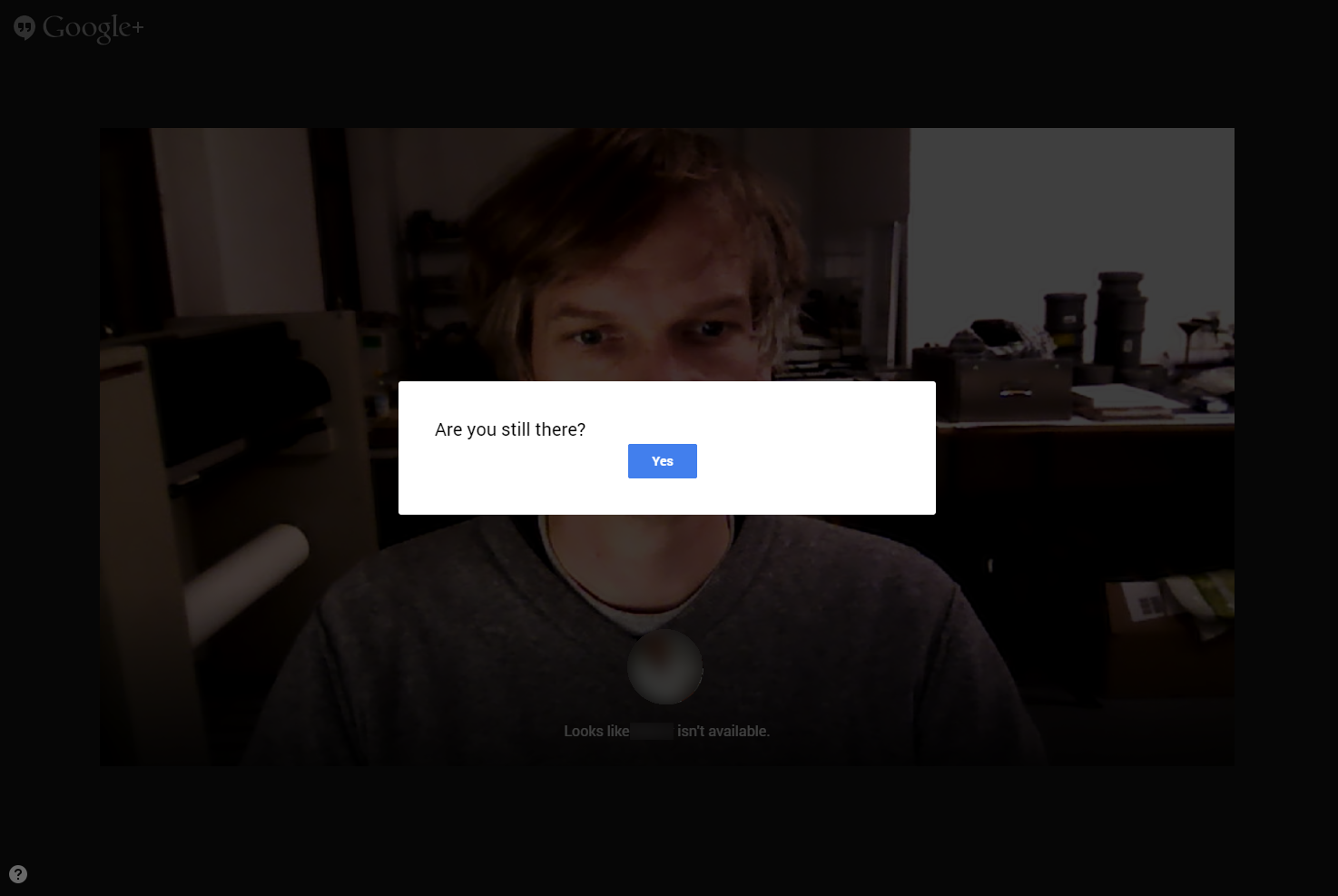
In the past two months there has been again a lot of international press about DeadDrops. The DeadDrops project is running since November 2010, for four and a half years now. After the initial press buzz in 2010/11 the project kept spreading online with occasional press like after the Snowden releases etc. But just since the beginning of 2015 there was a lot of press all over again. It is really hard to tell how such a press wave is starting on a project which is already running for such a while but I assume after almost 5 years there is a new generation of Internet users and press people who haven’t heard about DeadDrops yet. Through some big blogs in the US it reached the south american news, spreaded there and also made it back to Europe. I ve listed a selection of press links at the end of this post. Please also see the nice DeadDrops youtube playlist somebody made.
In Germany the recent reports about DeadDrops had a special twist. End of February the yellow press style news paper Kölner Express had a piece about a bomb making plan PDF which was supposedly found on a DeadDrop in Cologne. The local and national press picked up quickly the story and my phone kept ringing for two weeks. It is astonishing how in 2015 you still have to explain to people that it is of course not a problem to find such a PDF with illegal tutorials on the Internet. Or yes! there could be a virus on the USB drive, like there could be a virus in this blog post. But in an era of constant fear about terror the suspicious USB drive in wall was a perfect story for them. I was only waiting for the ISIS connection. But again this was a good opportunity to explain that there is no use in censoring or prohibiting encryption or anonymous communication technologies because there is illegal activities. Like back in the days the ruling class tried to banish the brand new dangerous technology ‘book printing’ which radicalized all the young people. Especially journalists should be aware how important independent, encrypted, private communication is. In fact DeadDrops is not a very efficient communication technology but a good symbol on independent, open digital communication. So while the NSA has trojans installed on all our hard drives or access to millions of sim card keys we worry about a 20 year old anarchist cook book PDF on a flash drive in a wall in cologne. What a crazy world! :))
The actual great story about the Cologne DeadDrop is that this specific DeadDrop, which I made myself as part of a duo show with JODI at DAM Cologne in 2011, was still existing and working in 2015!! Until the police ripped it out and broke it to then hand it in at the at the LKA cyber security department to get it fixed. Of course the highlight is how the two police men are kneeling in front of the yellow banana (the gallery “certificate”) trying to understand what’s going on. In fact later the Kriminalpolizei called DAM gallery to have them explain what exactly this USB stick is about and what the DeadDrops project is etc. On the same day I made this popular tweet about the whole story.
Of course I am very happy about all the attention for DeadDrops. It is very interesting to witness how the perspective on such a project has changed over the past five years, especially since 2013. I am glad to see how this project is still going on and how it has inspired so many people over the years. Thanks to all the deaddroppers out there!! You are awesome!!
Aram Bartholl, March 2015
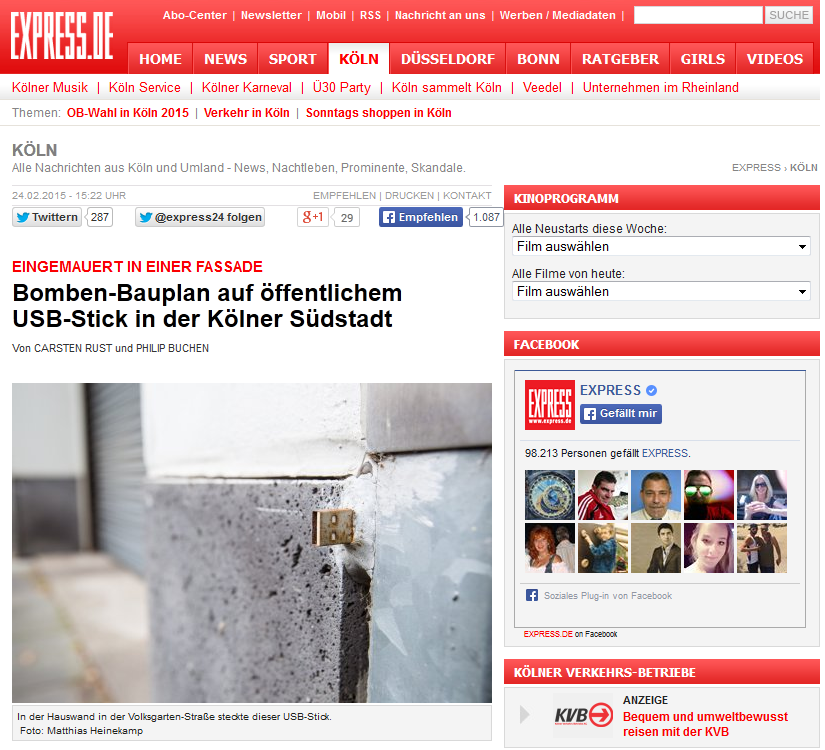
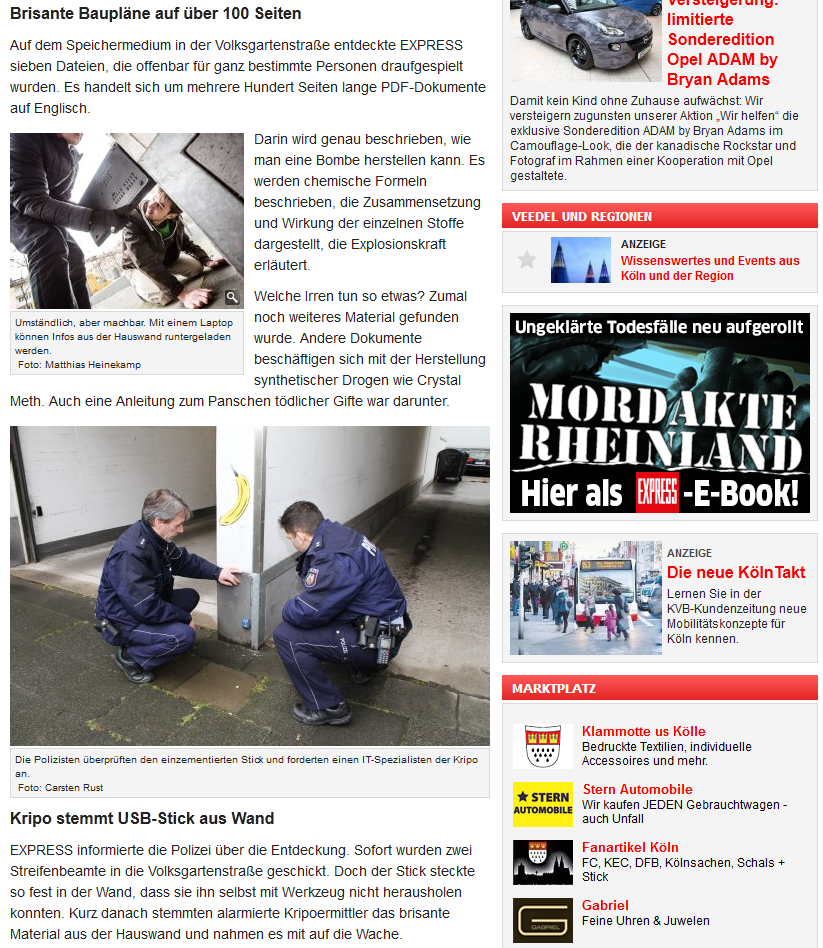
LINKS:
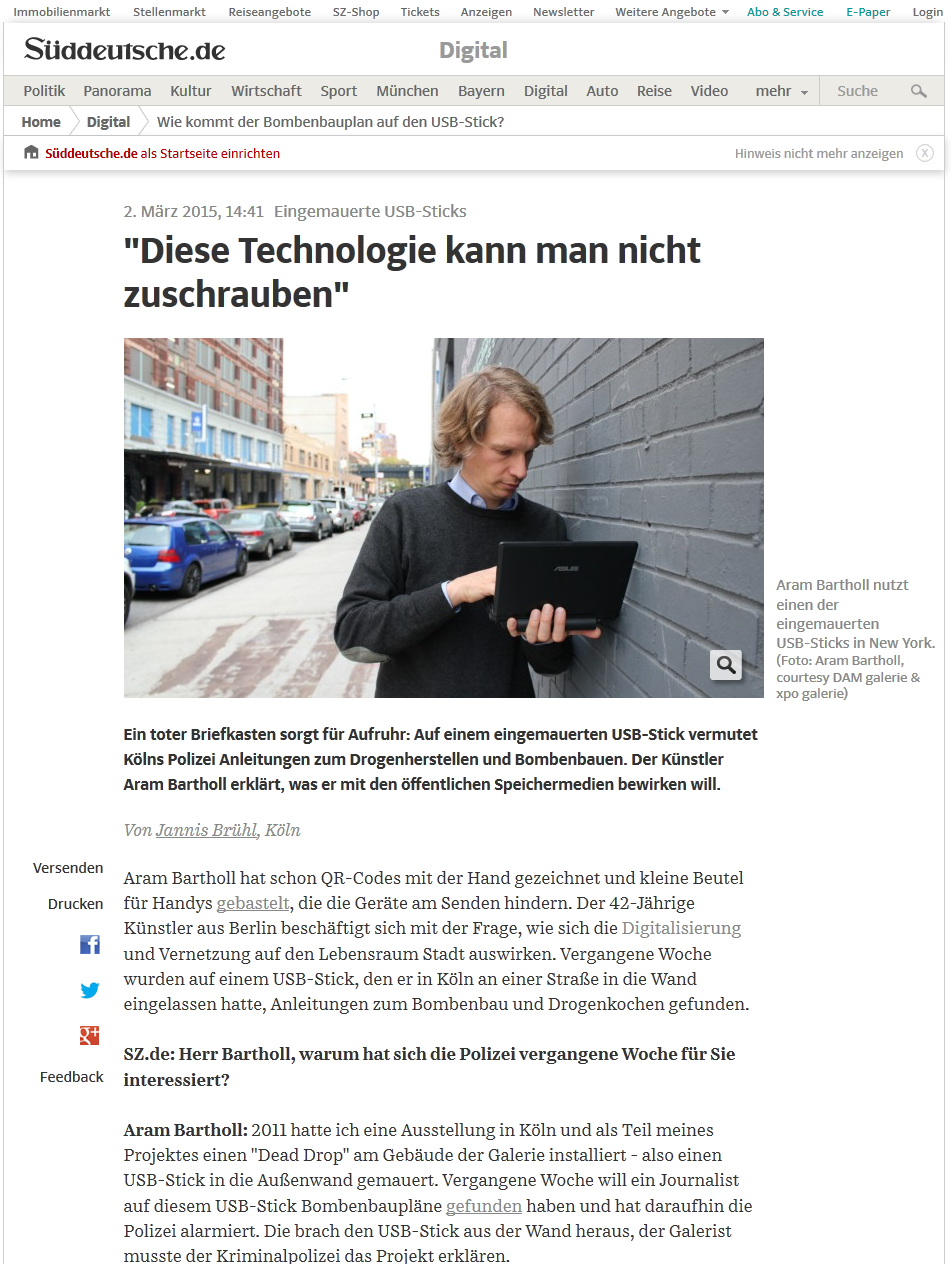
Full Interview at Sueddeutsche.de:
German:
POPULAR TWEET
the moment when the #KRIMINALPOLIZEI calls your gallery to get explained your ART! #DEADDROPS http://t.co/eUEHxlCXP2 pic.twitter.com/2FmryheOtw
— Aram Bartholl (@arambartholl) 24. Februar 2015
Current & upcoming shows / talks / workshops
29.8.2015
Keep Alive
Springhornhof Neuenkirchen, Germany
with Leuphana, curated by Andreas Broeckmann
16.6.-21.6. 2015
PBKAC IMHO
LISTE – Art Fair Basel with HeK , House of Electronic Arts Basel
with: Aram Bartholl, Constant Dullaart, Raquel Meyers, Evan Roth
30.5.-1.8.2015
AESTHETICA
50 Years of Computer Generated Art
DAM Gallery Berlin
with: Aram Bartholl, DE, Horst Bartnig, DE, Peter Beyls, BE, Vuk Cosic, SL, Hans Dehlinger, DE, Patrick Lichty, USA, Rafael Lozano-Hemmer, MEX-CAN, Manfred Mohr, DE, Vera Molnar, F, Frieder Nake, DE, Georg Nees, DE, Casey Reas, USA, Sommerer & Mignonneau, A – F, Roman Verostko, USA, Mark Wilson, USA and more….
28.5.-30.8.2015
Poetics and Politics of Data
HeK , House of Electronic Arts Basel
23.5.-31.5.2015
Human Futures: Shared Memories and Visions
Quartier des spectacles & MUTEK, Montreal
22.5. – 23.8.2015
Art In The Age Of… Planetary Computation
Witte de With Center for Contemporary Art, Rotterdam
with: Bartholl, Aram; Biscotti, Rossella; Canell, Nina; Gerrard, John; Herregraven, Femke; Hirsch, Antonia; Khan-Dossos, Navine G.; Mundy, Owen; Paglen, Trevor; Raven, Lucy
18.5.-30.5.2015
F.A.T. GOLD
at Gray Area Foundation for the Arts, San Francisco
by F.A.T. lab, curated by Lindsay Howard
9.5.-7.6.2015
#watch22
Bonifaziusturm A, Mainz, Essenheimer Kunstverein
5.5.-7.5.2015
finding europe
re:publica conference, Station Berlin
30.4.-10.5.2015
Kongress der Möglichkeiten
HATE, Kunstraum Kreuzberg Bethanien
27.4.-3.5.2015
NODE15
Forum For Digital Arts, Frankkfurt
24.4.-5.7.2015
Hamster und Hipster: Zur Konsumästhetik des Mobiltelefons
Museum Angewandte Kunst in Frankfurt
24.4.-5.7.2015
Offline Art: Are you still there?
Museum Angewandte Kunst in Frankfurt
curated by Aram Bartholl
with: Alma Alloro, Anthony Antonellis, LaTurbo Avedon, James Bridle, Constant Dullaart, Claudia Mate, Eva & Franco Mattes aka 0100101110101101.org, Niko Princen, Sebastian Schmieg, UBERMORGEN, Addie Wagenknecht
22.4.-1.6.2015
ANALOG DIGITAL: INTERFERENZ
Motorenhalle. Projektzentrum für zeitgenössische Kunst, Dresden
17.4.-19.4.2015
playin’siegen
Urban Games Festival, Universität Siegen
7.4.2015
KILLYOURPHONE.COM
workshop at Parsons School Paris
8.4.2015
FMAC à l’école
FMAC, primary school 19°, Paris
28.3.-28.6.2015
#NEULAND
at Kunsthaus Kaufbeuren, Germany
with: Aram Bartholl, JODI und Evan Roth
20.2.-10.4.2015
Point Of View
solo show at Babycastles, New York City
The Youtube user #USBdeaddrop made an effort to collect all videos dealing with DeadDrops in one or the other way. The result is this beautiful playlist of news reports, tutorials, documentations and more. There are whole lot of clips I haven t even seen before. So cool!! Thx!!
Das kunsthaus kaufbeuren zeigt erstmals Gegenwartskunst aus dem digitalen Bereich und präsentiert Arbeiten von Aram Bartholl, JODI und Evan Roth. Die Künstler visualisieren unsere digitale Identität, die durch Browserverlauf und Suchhistorie beim täglichen surfen durch das Netz entsteht. Sie versuchen sich vorzustellen, wie sich ein Computer mit einem Eigenleben verhalten würde. Sie hinterfragen kritisch aber durchaus auch humoristisch in Videoarbeiten, Objekten und Browserkunst alle Aspekte unseres technologisierten Alltags und enthüllen seine besondere Ästhetik. Tauchen Sie ein in die erstaunliche Vielfalt der Digitalen Kunst!
www.kunsthaus-kaufbeuren.de/